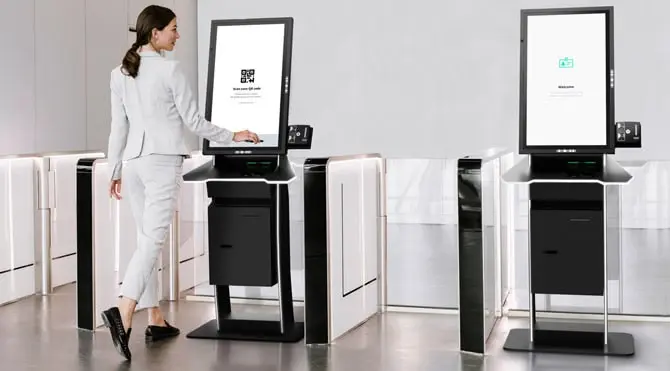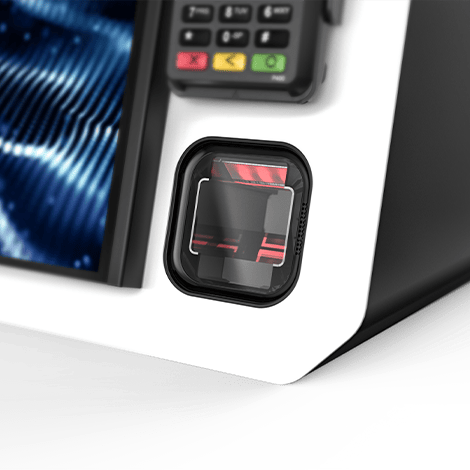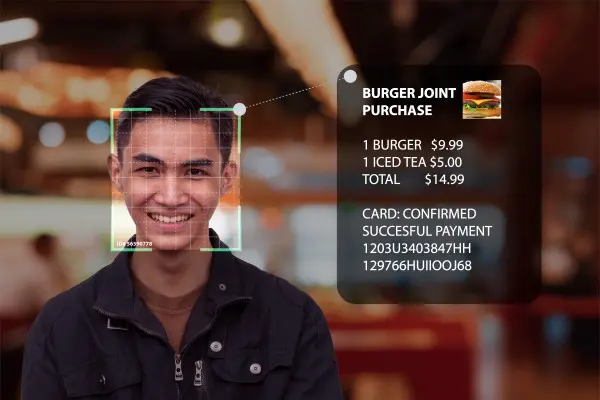Peripherals
Transform kiosks into powerful, interactive service hubs
From payments and access to charging and check-ins, peripherals like card readers, QR scanners, printers and cameras enable secure, seamless transactions while elevating user experiences. The result – faster service, smoother and more intuitive operations and a sleek, self-service solution that keeps customers coming back.

Trusted by industry leaders to power better customer experiences
Readers and Sensors
QR and barcode scanning solutions for touch-free kiosk services
Perfect for check-ins, payments and loyalty programs, use these peripherals to speed up interactions, reduce errors and deliver a smooth, modern user experience while capturing valuable data for smarter operations.
-
 Push promotions and product information when a customer walks by
Push promotions and product information when a customer walks by
-
 Speed up check-ins or guide guests through venues
Speed up check-ins or guide guests through venues
-
 Provide real-time updates, navigation and personalized content
Provide real-time updates, navigation and personalized content


Visuals and Voice
Camera and voice recognition peripherals for contactless interactions
Enable secure, personalized service through facial recognition, voice commands and proximity sensors. Enhance accessibility while capturing anonymous analytics data to optimize operations
-
 Boost user engagement
Boost user engagement
-
 Streamline transactions
Streamline transactions
-
 Make your kiosks smarter, safer, and more user-friendly
Make your kiosks smarter, safer, and more user-friendly
Payments and Printers
Payment processing and receipt printer integrations for self-service kiosks
Integrate card readers, NFC payments, receipt printers and barcode scanners to create complete self-service checkout solutions. Support all payment types while providing instant printed or digital receipts.
-
 Accept payments anytime without staff
Accept payments anytime without staff
-
 Print receipts, tickets and confirmations instantly
Print receipts, tickets and confirmations instantly
-
 Eliminate lines with multiple self-service stations
Eliminate lines with multiple self-service stations

Discover the versatility built into each product
Built for Every Environment
Trust in ruggedized, rated, reliable and robust devices of all shapes and sizes that perform flawlessly indoors or out.
Engage and Inform
Guide users through effortless, self-driven, interactive experiences or stream advertisements and promotions 24/7 on optically bonded, enhanced viewing touch screens.
Modular in Design
Easily configure, connect and scale devices to suit different locations, functions and use cases, while streamlining maintenance, serviceability and operational expenses.
Unapologetically Authentic
Fit any space with aesthetics and branding that drives emotional resonance and authentic connections to your true brand.
Industry applications for Peripherals
Sports Arenas
Guide fans from parking to seats
Interactive paths that simplify navigation and amplify sponsor engagement
Healthcare Facilities
Simplify complex patient journeys
Real-time wayfinding that adapts to emergencies and staffing changes
Retail Spaces
Convert browsers to buyers
Shelf-edge experiences that bridge digital browsing and physical products
More Information
Essential Peripheral Components for Complete Kiosk Solutions
Kiosk peripherals transform basic interactive displays into comprehensive service stations capable of handling complex transactions and user interactions. MetroClick’s peripheral ecosystem encompasses payment processing devices, document handling equipment, identification systems, and accessibility components that extend kiosk functionality beyond simple touch interactions. These hardware additions enable businesses to automate previously manual processes while maintaining the security and reliability customers expect from self-service solutions.
The selection of appropriate peripherals determines a kiosk’s ability to serve its intended purpose effectively. A retail price-check station might require only a barcode scanner, while a government services kiosk needs document scanners, printers, and payment processors. Understanding peripheral compatibility, integration requirements, and maintenance considerations ensures successful deployments that meet user needs without overwhelming them with unnecessary complexity.
Payment Processing Hardware Integration
Modern kiosks must accommodate diverse payment preferences ranging from traditional magnetic stripe cards to emerging contactless technologies. EMV chip readers provide secure card processing meeting current banking standards, while NFC modules enable tap-to-pay functionality for cards and mobile wallets. Cash handling peripherals, including bill acceptors and coin mechanisms, serve markets where cash transactions remain prevalent, particularly in unbanked populations or international deployments.
Payment peripheral selection involves balancing security requirements, transaction speed, and user familiarity. Encrypted PIN pads protect sensitive data during entry while maintaining PCI compliance. Multi-currency bill validators automatically detect and verify various denominations, reducing fraud risks. Change dispensers ensure exact change availability, eliminating a common friction point in cash transactions. These components work together, creating seamless payment experiences regardless of customer preferences.
Document Capture and Output Devices
Document handling peripherals enable kiosks to process physical paperwork in digital workflows. High-speed document scanners capture identification cards, contracts, and supporting documentation with automatic image enhancement, ensuring legibility. Duplex scanning capabilities process double-sided documents without user intervention. OCR integration extracts text data for automated form filling and verification processes.
Thermal receipt printers provide transaction confirmations without ink replacement requirements, reducing maintenance needs. Full-page laser printers handle complex documents, including contracts, tickets, and certificates. Print management software queues jobs efficiently while monitoring supply levels for proactive maintenance. Secure printing options hold documents until user authentication, protecting sensitive information in shared environments.
Biometric and Identification Technologies
Advanced Authentication Peripherals
Biometric peripherals enhance security while simplifying user authentication across various applications. Fingerprint readers provide quick identity verification without passwords or cards, particularly valuable for employee time tracking or secure area access. Facial recognition cameras enable touchless authentication, addressing hygiene concerns while maintaining security. Iris scanners offer the highest accuracy levels for applications demanding exceptional security.
Integration considerations for biometric peripherals include enrollment processes, template storage security, and fallback authentication methods. Privacy regulations influence biometric data handling requirements across jurisdictions. Liveness detection prevents spoofing attempts using photos or replicas. Multi-factor authentication, combining biometrics with traditional credentials, provides layered security for sensitive applications.
ID Card and Passport Readers
Government and healthcare applications require specialized peripherals for official document verification. Passport readers extract data from machine-readable zones and RFID chips while verifying document authenticity. Driver’s license scanners decode barcodes and magnetic stripes while capturing images for visual verification. Smart card readers interface with employee badges, membership cards, and government-issued IDs containing embedded chips.
Document verification peripherals must handle various global standards and formats. UV light modules detect security features invisible under standard lighting. Database connectivity enables real-time verification against authoritative sources. Age verification algorithms support compliance with age-restricted product sales. These capabilities transform kiosks into trusted verification points for sensitive transactions.
Specialized Input and Output Peripherals
Barcode and QR Code Scanning
Scanning peripherals bridge the physical and digital worlds by instantly capturing encoded information. 2D imaging scanners read both traditional barcodes and QR codes from products, tickets, and mobile phone screens. Omnidirectional scanners eliminate precise positioning requirements, speeding checkout processes. Long-range scanners accommodate bulky items without lifting, making them ideal for retail environments.
Scanner integration extends beyond simple data capture to trigger complex workflows. Product lookups retrieve pricing, inventory, and description information. Ticket validation confirms authenticity while preventing duplicate use. Package tracking updates delivery status through supply chains. Mobile coupon redemption processes digital offers seamlessly. These applications demonstrate how scanning peripherals enable sophisticated self-service capabilities.
Accessibility and Assistive Technologies
Compliance with accessibility standards requires specialized peripherals serving users with diverse abilities. Audio jacks and speakers enable screen reader functionality for visually impaired users. Braille keypads provide tactile input options. Height-adjustable card readers accommodate wheelchair users. Large-button keypads assist users with limited dexterity.
Assistive peripheral selection considers both regulatory requirements and genuine usability improvements. Voice guidance systems provide step-by-step instructions through transactions. Hearing loop systems transmit audio directly to hearing aids. High-contrast displays improve readability for users with limited vision. These accommodations expand kiosk accessibility while demonstrating a commitment to inclusive design in corporate environments.
Environmental and Security Peripherals
Operating conditions influence peripheral selection for reliable long-term performance. Weatherproof enclosures protect outdoor installations from moisture and temperature extremes. Vandal-resistant designs withstand deliberate damage attempts in unsupervised locations. Industrial-grade components handle continuous operation in demanding environments.
Security peripherals protect both the kiosk and its users. Surveillance cameras deter vandalism while documenting incidents. Motion sensors activate displays when users approach, conserving energy during idle periods. Tamper detection switches alert administrators to unauthorized access attempts. Emergency call buttons connect users with assistance when needed. These protective measures ensure kiosk availability while maintaining safe operating environments.
Integration Architecture and Management
Successful peripheral deployment requires a robust integration architecture supporting diverse hardware combinations. USB hubs provide adequate ports for multiple devices while maintaining signal integrity. Power management systems prevent overloading while enabling controlled shutdowns. Cable management solutions organize connections, preventing accidental disconnections.
Remote management capabilities enable centralized peripheral monitoring across distributed deployments. Status reporting identifies failing components before complete failure. Firmware updates deploy automatically,y maintaining security and functionality. Usage analytics reveal peripheral utilization patterns informing future deployments. These management tools reduce maintenance costs while maximizing uptime across industries.














